For more information contact Robin W. Baird at rwbaird (at) cascadiaresearch.org
The most recent updates are at the bottom of the page.
From April 17 through May 16, 2008 we will be undertaking research off the island of Hawai‘i (the “Big Island”) in collaboration with the Wild Whale Research Foundation, and funded by the Southwest Fisheries Science Center of NOAA Fisheries (supported by the U.S. Navy N45), the Pacific Islands Fisheries Science Center, the Wild Whale Research Foundation, the Northwest Fisheries Science Center, and Dolphin Quest. The research team includes Greg Schorr and Robin Baird of Cascadia, Daniel Webster and Dan McSweeney of the Wild Whale Research Foundation, Erin Oleson of Scripps, and Jay Barlow of NOAA SWFSC, and a number of volunteers. We have two main goals for this project: 1) to obtain additional information on movement patterns of Cuvier’s and Blainville’s beaked whales, through the deployment of satellite tags; and 2) to examine the overlap of the offshore and island-associated populations of false killer whales, with surveys offshore of the island on a larger charter vessel. We have a number of additional goals, including:
- Deployment of “medium-term” satellite tags on pilot whales, false killer whales, and possibly melon-headed whales, to examine offshore and inter-island movements (in collaboration with Brad Hanson at the Northwest Fisheries Science Center and Russ Andrews of the University of Alaska, Fairbanks)
- Deployment of a HARP (High-frequency Acoustic Recording Package) to acoustically monitor cetacean presence off the west side of the island, and to survey in the area of the HARP to compare sightings of different species to acoustic detections. This is a collaborative effort with Erin Oleson at Scripps.
- Collection of skin/blubber samples from biopsies and from suction-cups for examination of stock structure (in collaboration with Susan Chivers and Karen Martien of the Southwest Fisheries Science Center, and Sarah Courbis of Portland State University) and trophic ecology (in collaboration with Jason Turner of the University of Hawai‘i, Hilo)
- Collection of fecal samples to examine diet (a collaborative project with Mike Ford of the Northwest Fisheries Science Center, Seattle)
- Photo-identification of 10 species of odontocetes to examine residency/movements
- Collection of survey and sighting data for examination of habitat use
- Collecting dead cephalopods for trophic ecology studies
This will be our first trip back to Hawaii since August of last year. We have surveyed in April and May in the past, in April 2006 and May 2003, and found both trips to be very productive. Waters are relatively cool (~24-25 degrees Celcius) at this time of the year.
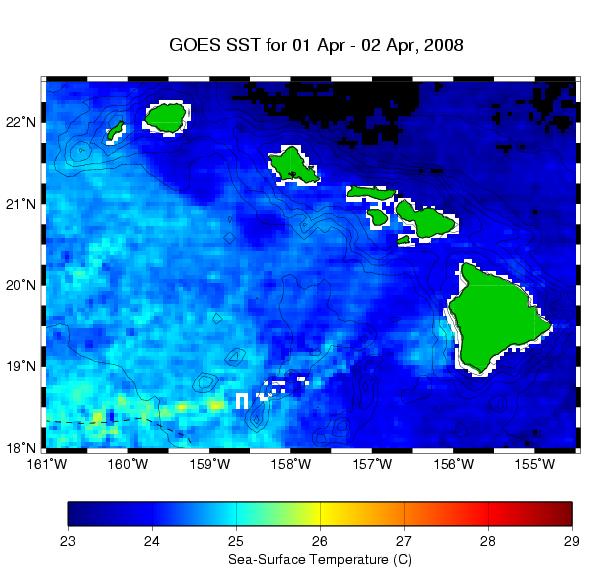
Sea surface temperature data from the NOAA OceanWatch – Central Pacific site.
April 18 update
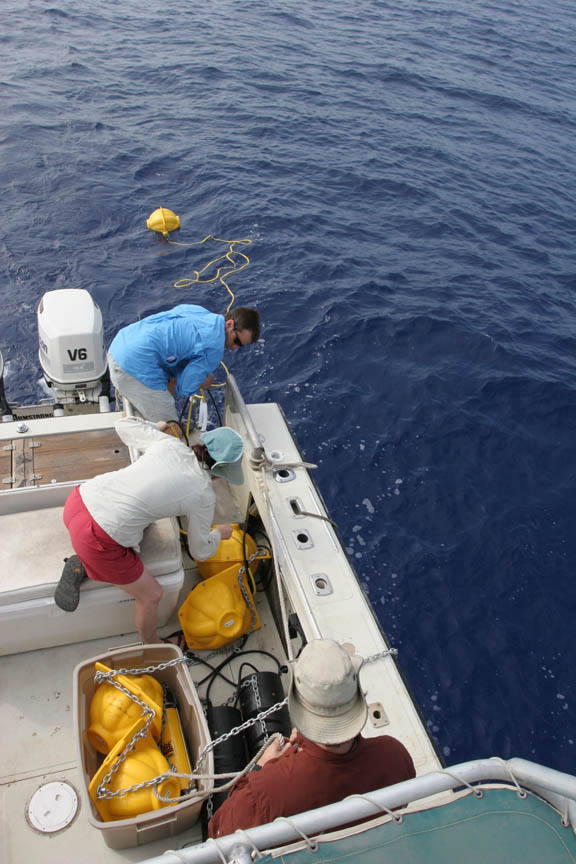
Deployment of a HARP off Kona, April 18. Photo by Robin Baird.
On our first day out (the 18th), first thing in the morning we successfully deployed a HARP, more-or-less in the same location as the one we deployed last year. This acoustic recording package will stay on the bottom recording for five minutes on, three minutes off, until mid-July, when we will recover it on our next trip out. The system records up to 100 KHz, so will pick up the vocalizations of most species of whales and dolphins that use the area.
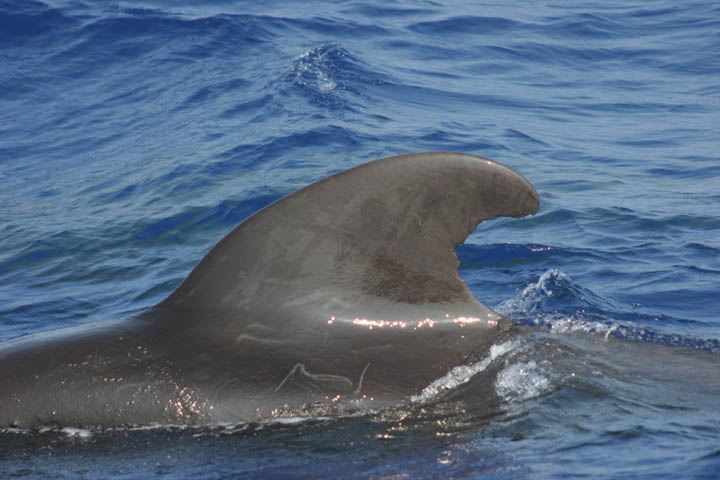
Adult male pilot whale April 18, 2008. Photo by Daniel Webster.
Later in the morning and early afternoon we came across three separate groups of pilot whales. Pilot whales are our most frequently sighted species of cetacean off the island, and we are photo-identifying individuals to be contributed to a collaborative photo-identification catalog between the Wild Whale Research Foundation and Cascadia Research. Sabre Mahaffy is currently analzying these photos as part of her Masters research at Portland State University. Two of the pilot whales encountered were individuals that were previously tagged (in April and November 2006) with our dart satellite tags, so it was very good to get re-sightings of these individuals to document how the tag attachment site heals.
April 19 update
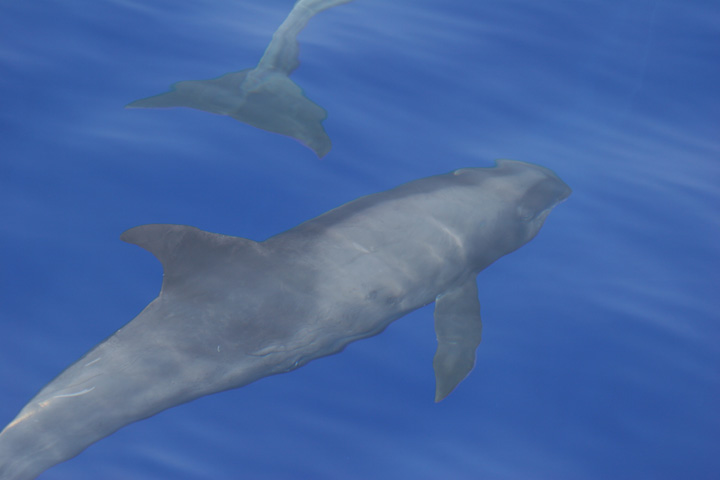
Melon-headed whale bowriding on our research boat. Note the pointed pectoral flippers, the facial “mask”, and the cape that extends very low below the dorsal fin. Photo by Robin Baird.
On our second day on the water we were lucky enough to encounter a group of melon-headed whales. This species is seen relatively infrequently – our last encounter was in July 2006, despite several weeks of field work each in November/December 2006 and August 2007. Melon-headed whales typically travel in groups of several hundred individuals, and we were surprised to find only a group of ~10-15 individuals. We followed the small group for almost two hours before they met up with a much larger group, and we ended the encounter with ~325 individuals in the group. As well as photographing individuals for our photo-identification catalog (graduate student Jessica Aschettino, from Hawaii Pacific University, is currently working on this catalog as part of her Masters degree), we collected a number of biopsy samples (for genetics and stable isotopes studies), and deployed two satellite tags (see photo below).
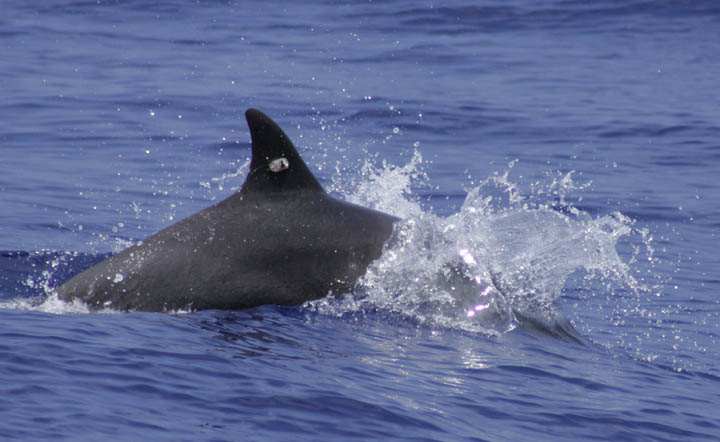
Satellite tagged melon-headed whale off Kona, April 19. Photo by Dan McSweeney.
To the best of our knowledge these satellite tags are the first ever deployed on free-ranging melon-headed whales, and will give information on movement patterns of this population. In particular, it will allow us to assess whether these are part of an island-associated population or a pelagic population visiting the islands, as well as give information on movement rates among and around the islands.
April 23 update
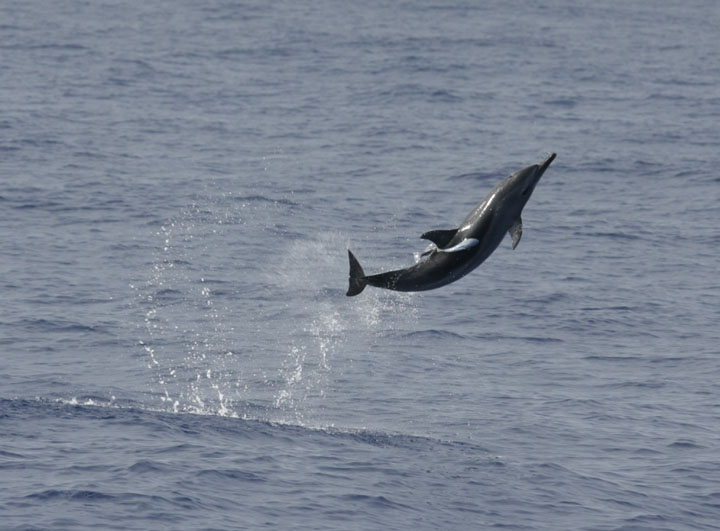
Pantropical spotted dolphin leaping to remove remora, April 21, offshore Kona. Photo by Jay Barlow.
On April 21 we headed offshore on an overnight trip on the New Horizon, a 50′ charter vessel. This was the first of five of these two-day trips, to try to assess the overlap of the island-associated and offshore populations of false killer whales. Our route took us over Indianapolis Seamount, approximately 70 km offshore, and to the Jaggar/Perret seamount complex, which span an area from approximately 105-145 km from shore. Although Indianapolis is a relatively deep seamount (~3200 m), part of the Jaggar/Perret seamount complex rises within 1000 m of the surface. This was our first visit ever to any of the seamounts west of the island of Hawaii, and there is little information on cetacean presence in the area.
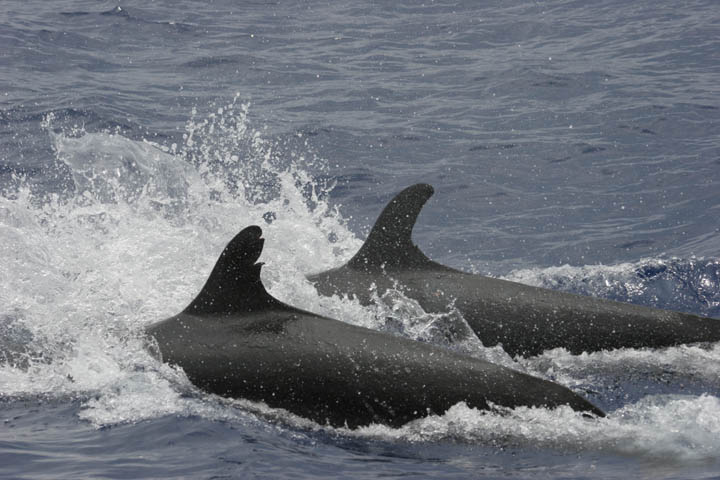
False killer whale west of Jaggar Seamount, April 21. Photo by Erin Oleson.
Although conditions on the offshore trip were not ideal (a lot of Beaufort 3 and 4, combined with swell coming from two directions), the trip was extremely productive. On the way offshore on the 21st we encountered a number of groups of pantropical spotted dolphins and one group of rough-toothed dolphins. Once at the Jaggar/Perret seamount complex we encountered two groups of false killer whales, were able to obtain biopsies from both groups (for genetic analyses, to determine whether they are part of the island-associated or offshore populations), and deployed one satellite tag, as well as photo-identified at least 13 individuals in the two groups. On the 22nd we encountered another group of false killer whales in the same area and photo-identified at least two individuals. Annie Gorgone has quickly compared the photos to our catalog for this species but has found no matches, suggesting they are part of the offshore population. We also collected what appears to be a deep-water octopus, found dead floating near the surface, which will be sent to Bill Walker of the National Marine Mammal Laboratory for identification.
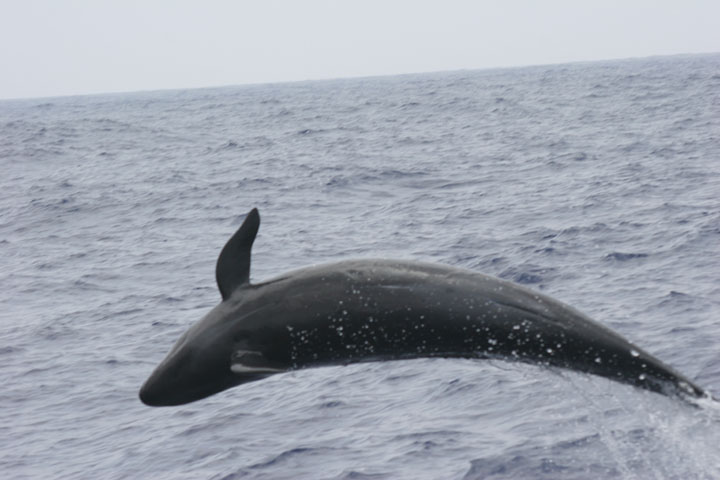
False killer whale leaping at Jaggar Seamount, April 21. Photo by Daniel Webster.
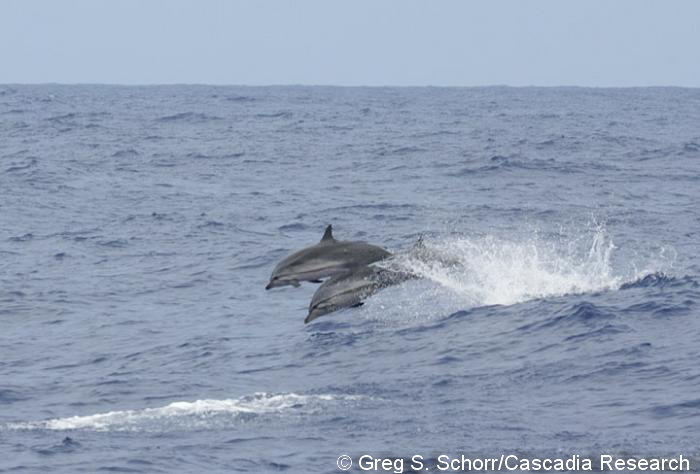
Striped dolphins seen offshore of Kona, April 22. Photo by Greg Schorr.
While off effort at the seamounts the night of the 21st two Risso’s dolphins were observed, and on the way back in on the 22nd we encountered a group of striped dolphins, bringing the species total to 7 for only 5 days on the water.
April 26 update
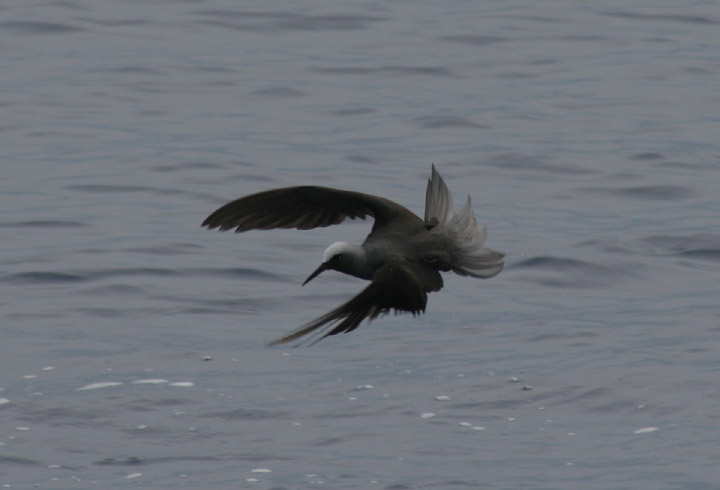
Noddy chasing fish, April 24. Photo by Robin Baird.
The last few days have been productive, with encounters with pygmy killer whales, striped dolphins, melon-headed whales, Risso’s dolphins, and short-finned pilot whales. We were able to deploy a third satellite tag on a melon-headed whale, and continue to receive locations from the first two tags deployed on melon-headed whales (both have moved between Oahu and Kauai!). We’ve also collected another floating squid (the fifth for the project so far), and today we detected one or more minke whale “boings” while towing an acoustic array while surveying offshore to the west of the island. A productive first 8 days here.
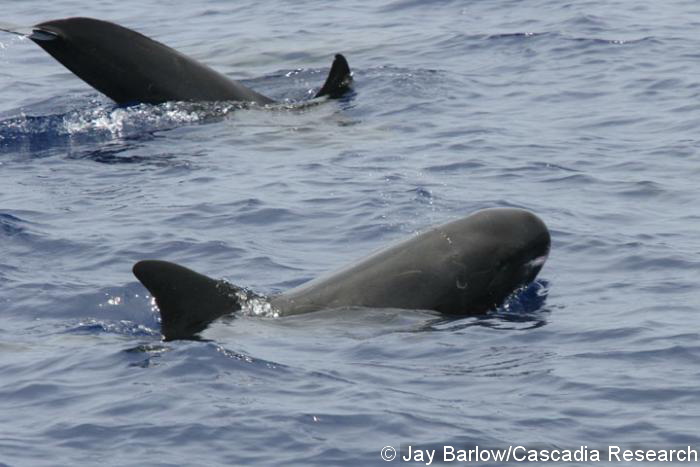
Pygmy killer whales off Kona, April 24. Photo by Jay Barlow.
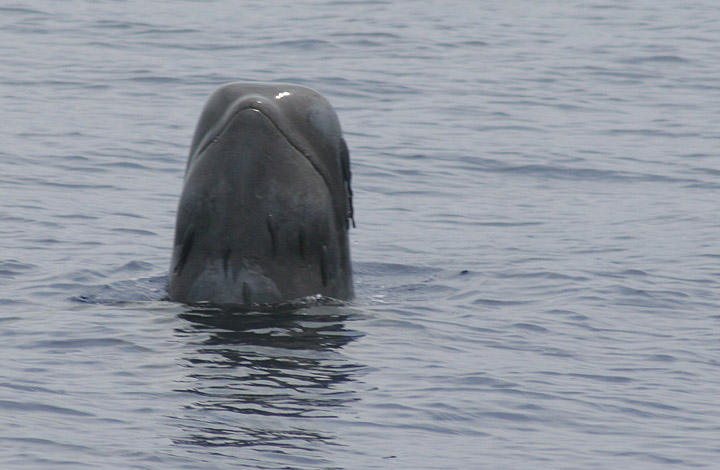
Spyhopping pilot whale with remoras, April 24. Photo by Robin Baird.
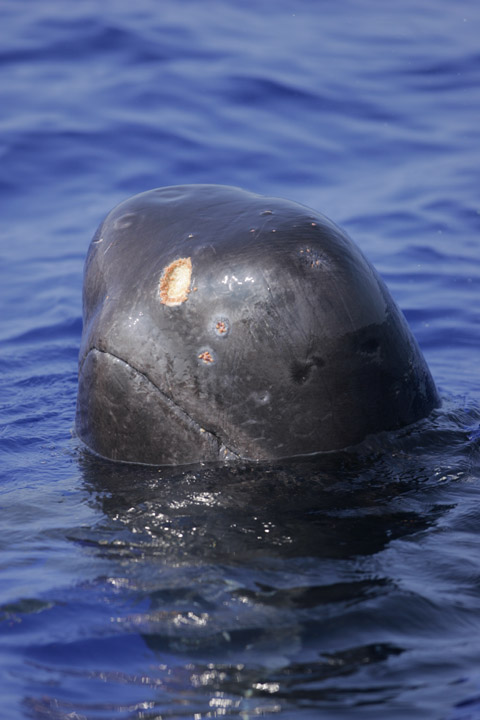
Spyhopping pilot whale with wound from cookie-cutter shark, April 25. Photo by Dan McSweeney.
April 27 update
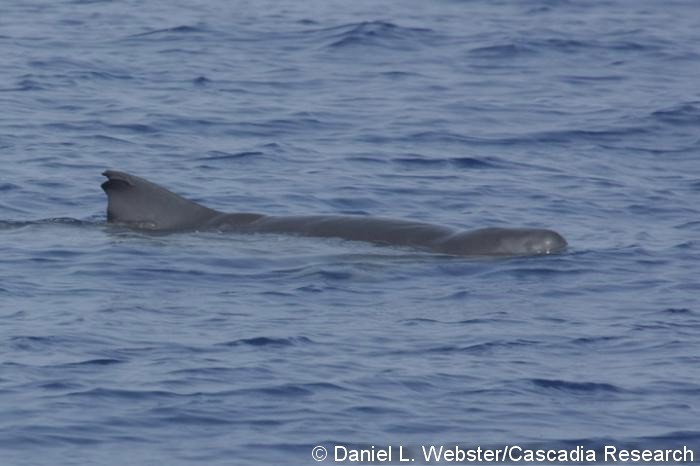
Dwarf sperm whale off Kona, April 27. Photo by Daniel Webster.
On April 27th we had our 10th species for the project, a group of dwarf sperm whales. We were able to stay with the group for an extended period and get identification photos of three individuals, including one very distinctive individual. We also had a sighting of an adult leatherback turtle, the first time we’ve seen a leatherback in Hawaiian waters.
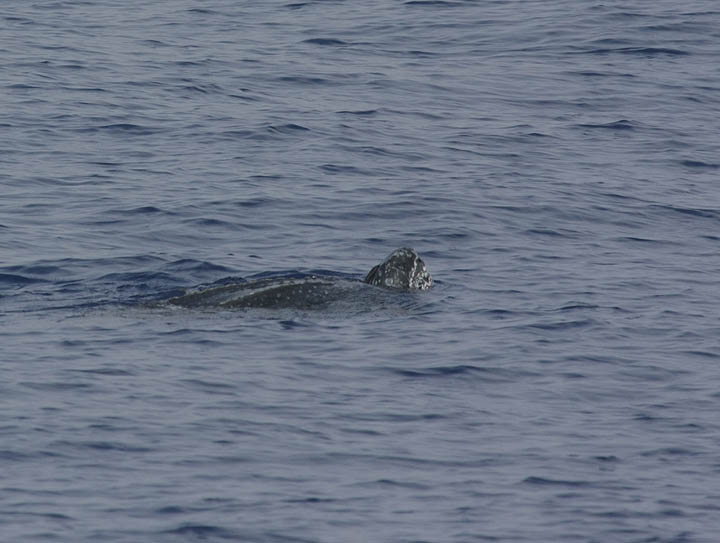
Leatherback turtle seen off Kona, April 27. Photo by Daniel Webster.
April 28 update
Today we deployed a suction-cup attached tag containing a Wildlife Computers Mk10 TDR/Fastloc GPS on a short-finned pilot whale. This tag records both the depth of the whale (once per second) and the location of the whale when at the surface. We hope the tag stays on through the night and we are able to recover it tommorrow.
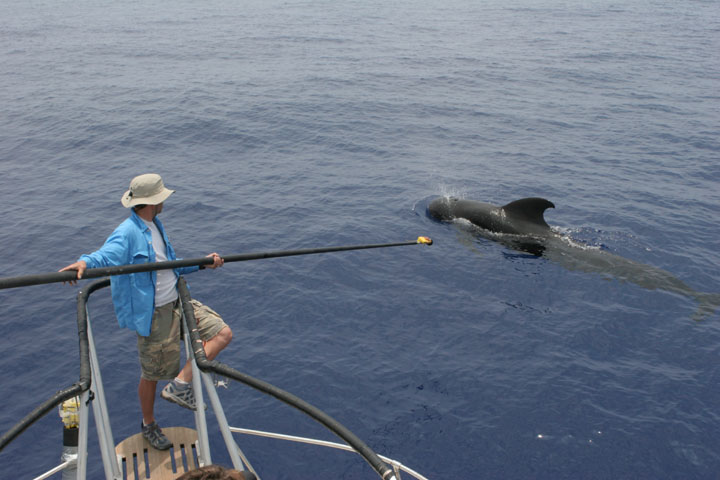
Daniel Webster attempting to deploy suction-cup attached time-depth recorder/Fastloc GPS tag on a pilot whale. Photo by Robin Baird.
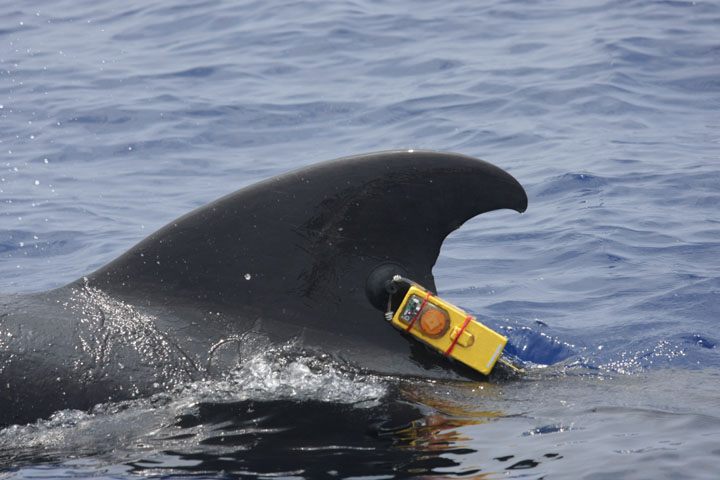
Pilot whale with time-depth recorder/Fastloc GPS tag, April 28. Photo by Greg Schorr.
April 30 update
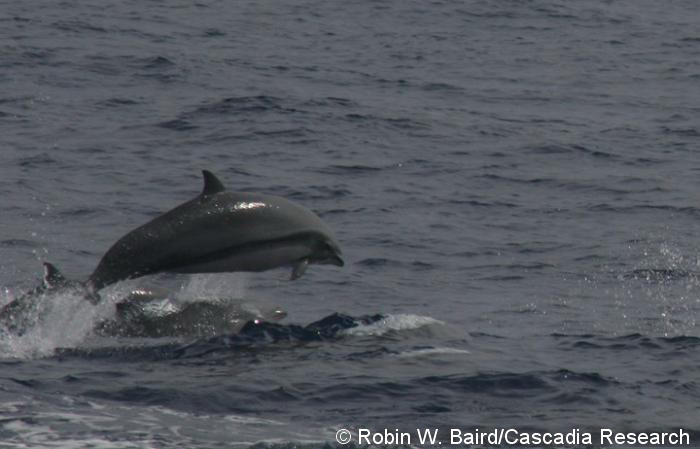
Adult male Fraser’s dolphin off Kona, April 30. Photo by Robin Baird.
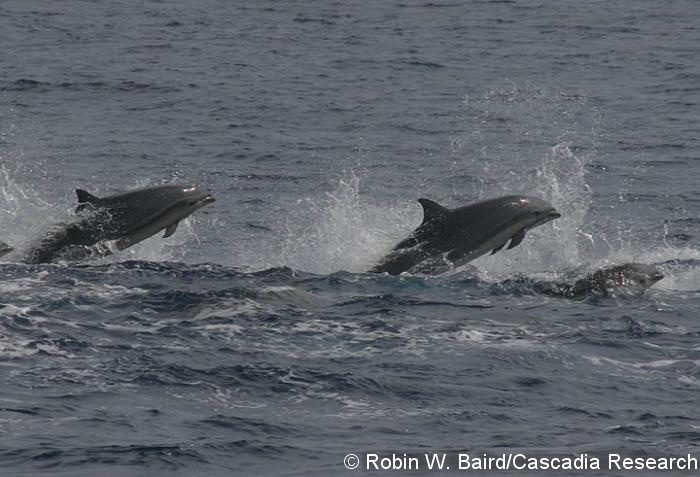
Fraser’s dolphins off Kona, April 30. Photo by Robin Baird.
Today we sighted our 18th species of odontocete in Hawaiian waters (and the 12th species for this trip), a group of ~85 Fraser’s dolphins! This was the first sighting of this species ever for everyone on board, so needless to say everyone was very excited. Fraser’s dolphins are a very poorly known species of tropical dolphin, typically found far from shore. To our knowledge this species has only been recorded in Hawaiian waters on two previous occasions, both in 2002 on the HICEAS cruise of NOAA Fisheries. Both sightings in 2002 were far to the west of the main Hawaiian Islands, with the closest over 1000 km west of Ni’ihau, so this should represent the first sighting around the main Hawaiian Islands. Our group was sighted within ~50 m of a group of melon-headed whales (including the third individual we satellite tagged last week).
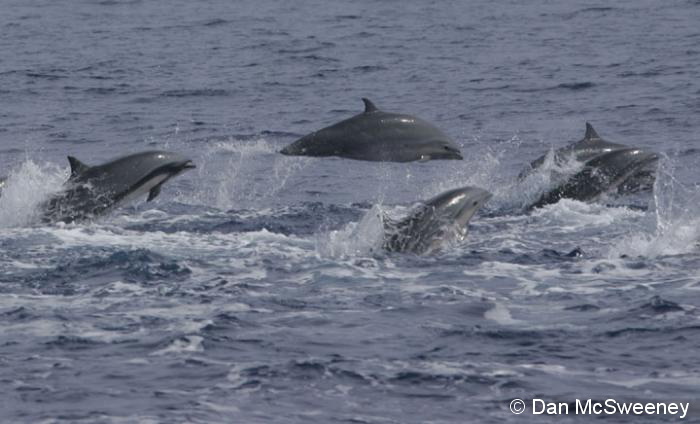
Fraser’s dolphin off Kona, April 30 Photo by Dan McSweeney.
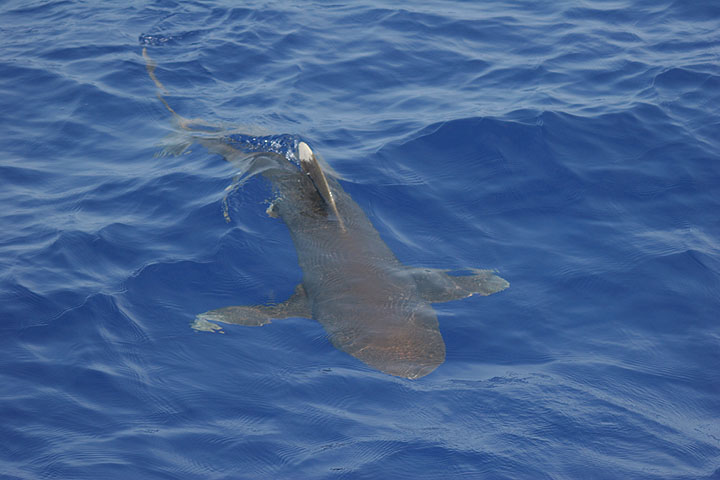
Oceanic white-tip shark, near group of melon-headed whales, April 30. Photo by Robin Baird.
May 5 update
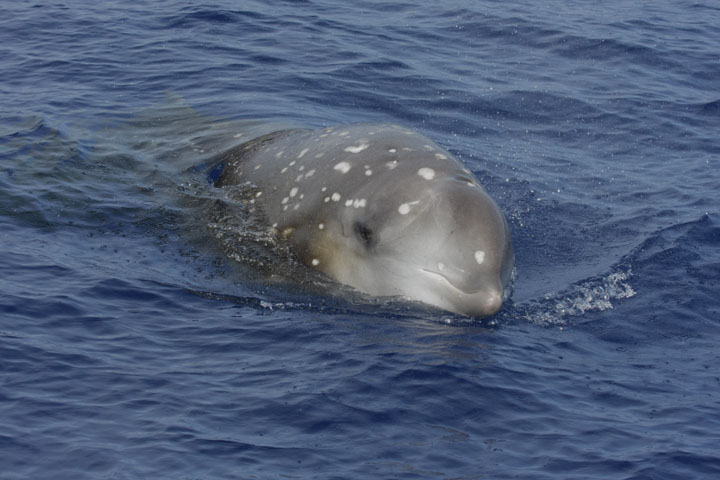
Adult female Cuvier’s beaked whale surfacing near our boat, May 5. Unlike some of the photos on this page, this photo has not been cropped, and was taken with a focal length of 100 mm (using a Canon 40D). Photo by Daniel Webster.
Today we had our first sighting of beaked whales for the trip, a group of three Cuvier’s beaked whales (two males and one female). Cuvier’s beaked whales are typically not easily approachable, but this encounter was different – the adult female in the group appeared quite curious about our research vessel, the first time we’ve had a “friendly” Cuvier’s beaked whale in Hawaii. The female circled our boat several times, and we were able to deploy a satellite tag (see below) to track her movements. We continued to follow the group and were able to deploy a second satellite tag on one of the adult males in the group. These are the second and third satellite tags we’ve deployed on this species (the first was tagged in 2006), and we are hoping these tags will give us information on movement patterns of these individuals.
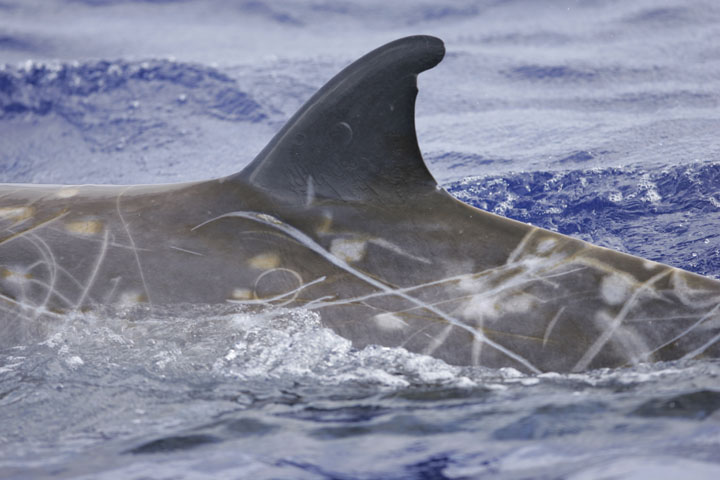
Adult male Cuvier’s beaked whale, showing oval scars from cookie-cutter sharks and linear scars from fighting with other male Cuvier’s beaked whales. Photo by Dan McSweeney. For those who have been following updates from our past field projects (see our update from November/December 2006), this is the same male we obtained 34 hours of dive data from in December 2006.
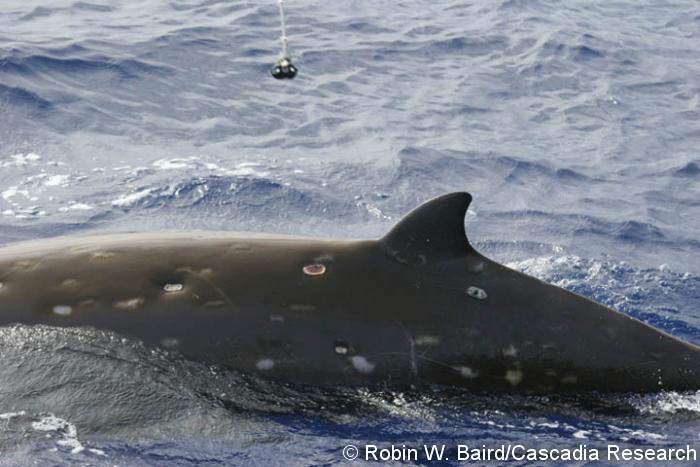
Adult female Cuvier’s beaked whale with satellite tag, immediately after tagging, May 5. The tag (gray in color with a black dot in the center) is visible just below and behind the fin. This individual also has a fresh wound from a cookie-cutter shark bite (in front of and below the fin) as well as numerous older scars from cookie-cutter shark bites. Photo by Robin Baird.
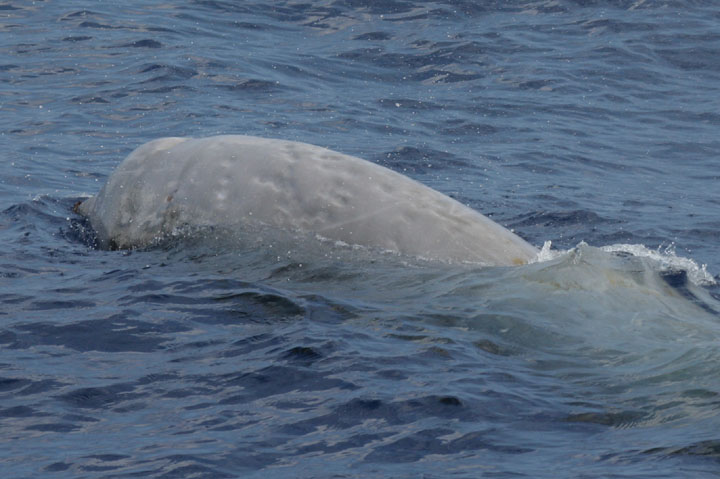
Adult male Cuvier’s beaked whale, May 5. Most adult males and occasional adult females have extensive white pigmentation over the front half of the body. Photo by Robin Baird.
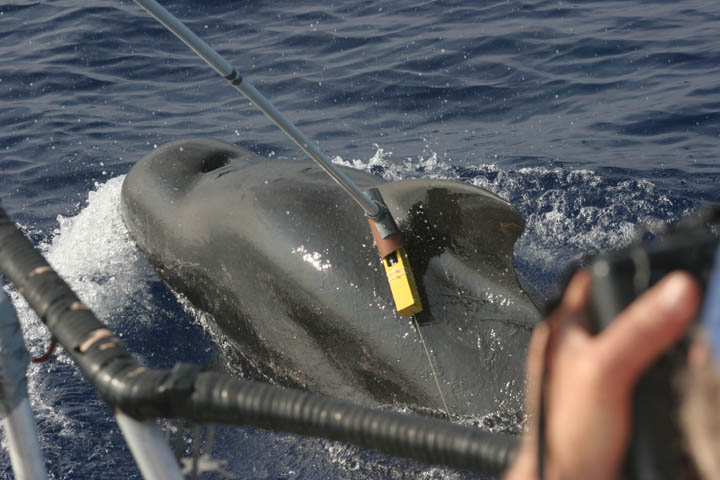
Deploying a suction-cup tag on a short-finned pilot whale. Photo by Mai Sakai.
We also encountered pilot whales today and were able to deploy a suction-cup attached tag containing a “Little Leonardo” micro-data logger, which includes a depth sensor, swim speed sensor, 3-axis magnetometer, and a 3-axis accelerometer, in collaboration with Dr. Masao Amano of Teikyo University of Science and Technology, and Dr. Mai Sakai and Dr. Nobuyuki Miyazaki of the University of Tokyo.
May 6 update
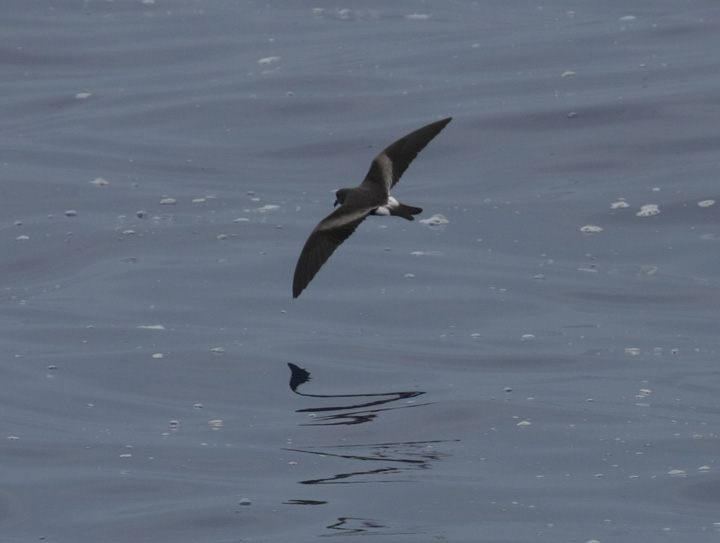
Leach’s storm petrel, May 6. Photo by Daniel Webster.
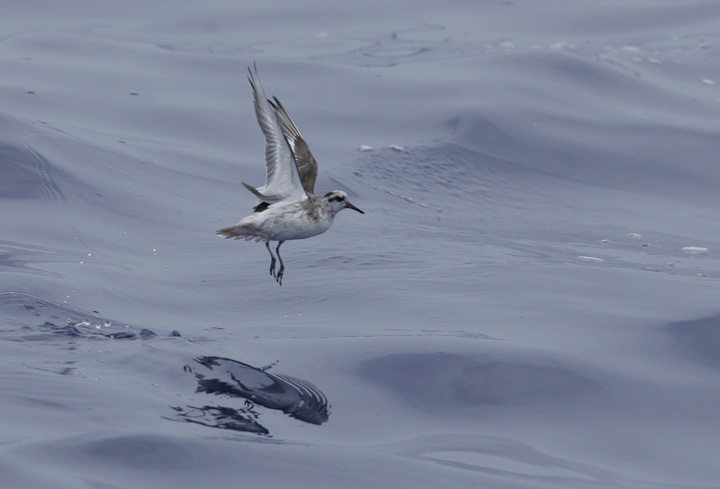
Red-necked? phalarope off Kona, May 6. Photo by Dan McSweeney.
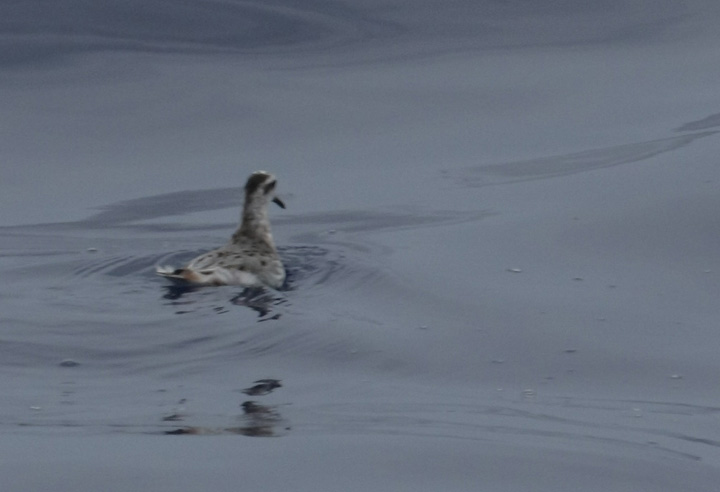
Red-necked? phalarope off Kona, May 6. Photo by Daniel Webster.
May 10 update
The last few days have been busy. We tried to recover the suction-cup attached “Little Leonardo” tag deployed on a pilot whale on May 5, but the tagged whale moved south out of our study area before the tag came off, and we heard the tag’s VHF signal May 7, floating to the SW of the island. Although we attempted to head in that direction, sea conditions prevented us from recovering the tag. However, there is a large eddy SW of the island, and if the tag is caught in the eddy it should be brought back closer to the island sometime in the next week or two.
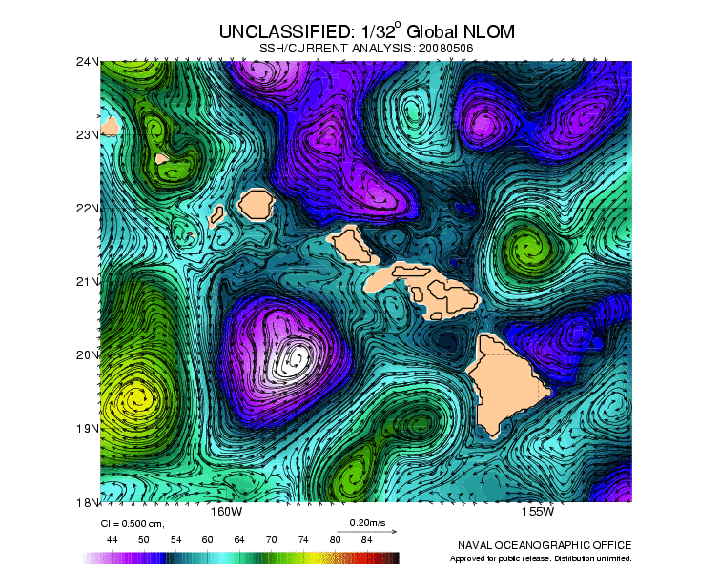
Sea surface height and current map from the Naval Oceanographic Office (see http://www7320.nrlssc.navy.mil/global_nlom32/haw.html) from May 6. We are hoping the tag will be caught in the large clockwise eddy to the SW of the island and be brought back closer to shore.
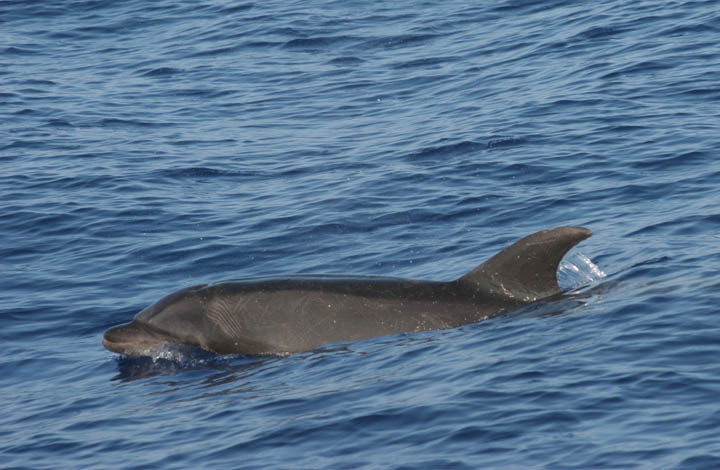
Bottlenose dolphin May 8. Photo by Andrea Bendlin.
On May 8th we documented our 14th species of odontocete for the trip, bottlenose dolphins. One lone individual was seen milling in the area of the Kona Blue fish net pens, and two larger groups (totalling ~22 individuals) were documented to the north. Also on the 8th we encountered our second group of sperm whales for the trip, about 10 individuals (females, juveniles and calves). We were able to get three fluke IDs from this group.
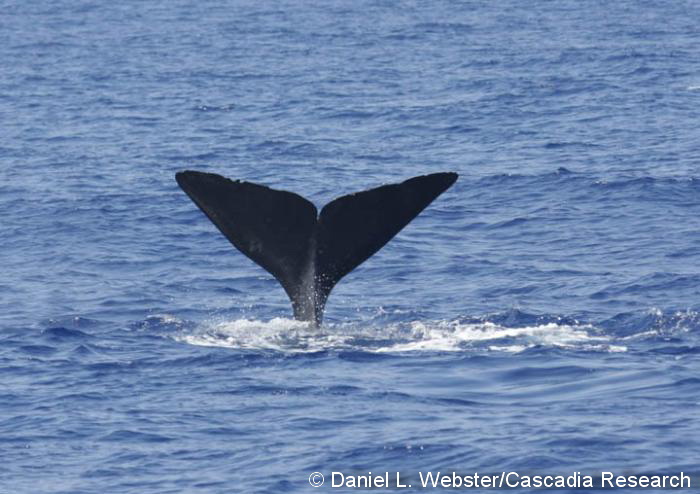
Sperm whale fluking off Kona, May 8. Photo by Daniel Webster.
On May 9th we attempted to head offshore for another overnight trip on the vessel “New Horizon”, but inclement sea conditions prevented us from getting more than about 50 km offshore, and we returned to the harbor late in the afternoon. If conditions allow we are hoping to get far offshore at least one more day during this trip. We did document a group of striped dolphins offshore.
May 14 update
Today we deployed an additional satellite tag on a short-finned pilot whale, the second deployed on this species for the trip. Locations from the first pilot whale we satellite tagged several weeks ago indicated the whale headed south of the island and started working its way up the east coast, and we are hoping this tag transmits for an extended period so we can assess movements of this species. We also collected samples from exhalations of several pilot whales (see photo below), as part of a collaborative project with Andrea Bogomolni of Woods Hole Oceanographic Institution and Kristi West of Hawaii Pacific University. This is a pilot project (no pun intended) to assess whether viral and bacterial fauna of this species in Hawaii can be examined using samples collected from exhalations. We also managed to recover a Mk10 time-depth recorder we had deployed on a pilot whale on the 10th of May. The tag stayed on just over 12 hours, but the whale had moved north out of our study area with the tag attached, and we were thinking we would not get the tag back. Fortunately the tag was caught in an eddy that brought it back further south (back into the area where we could recover it).
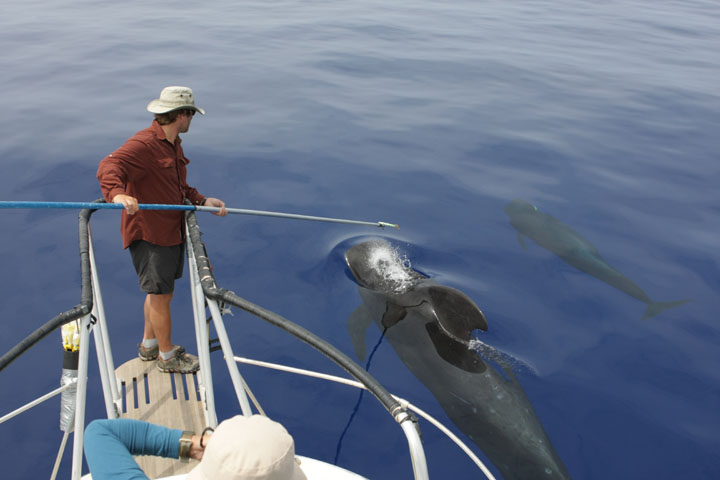
Greg Schorr collecting samples from an exhalation of a pilot whale, May 14. Photo by Robin Baird.
May 15 update
Today was our last day on the water for this trip. We were on the water 27 out of the last 28 days, covering over 3,700 km of trackline in >200 hours of search effort. We had 99 sightings of 14 species of odontocetes, with pilot whales by far the most frequently encountered species (41 sightings), followed by pantropical spotted dolphins (17 sightings) and rough-toothed dolphins (13 sightings). Overall the trip was extremely successful, with the first ever deployments of satellite tags on melon-headed whales, two deployments of satellite tags on Cuvier’s beaked whales (still receiving locations from these two whales), genetic and photographic samples of possible “offshore” false killer whales on Jagger Seamount, to the west of the island, and over 26,000 photographs, which will be used to help assess site fidelity, movements and population size of many of the species of odontocetes found in Hawaiian waters.
All photos on this page taken under NMFS Scientific Research Permits (Nos. 731-1774 and 774-1714). All photos are copyrighted and should not be used without permission.